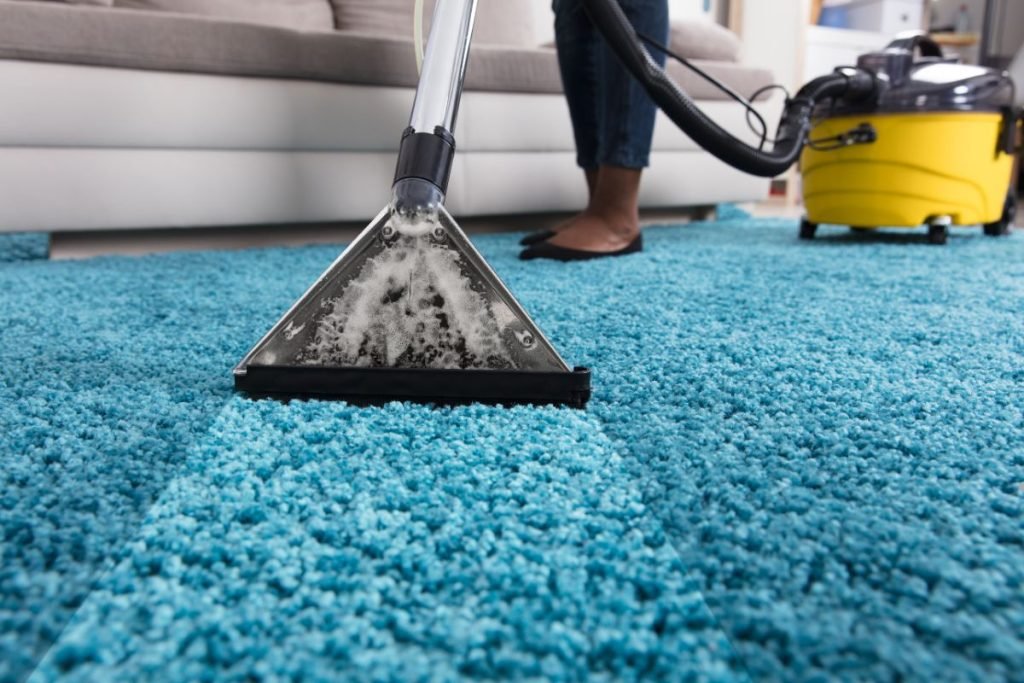
You’ve experienced a spill, a leak, or maybe minor flooding, and now your carpet is wet. The immediate question is often: Is it really that big of a deal? Can I just let it air dry? The short, simple, and most crucial answer is No, it is absolutely not okay to leave water sitting in your carpet. While a tiny spill wiped up immediately might be harmless, any significant amount of water left unattended poses serious risks to your carpet, your home’s structure, and even your health. This article dives into why leaving water in your carpet is a bad idea, the hidden dangers, what steps to take immediately, and when it’s essential to call in professionals.
The Short Answer: Why Leaving Water is a Bad Idea
Even before the long-term problems set in, leaving water in your carpet causes immediate issues. You’ll likely notice unpleasant, musty damp carpet smell within hours as bacteria begin to multiply in the moist environment. Water can also cause dyes in the carpet fibers to bleed or run, leading to discoloration or staining. Furthermore, moisture weakens the carpet’s backing and fibers, making it more susceptible to tearing and wear. Simply put, a soggy carpet quickly becomes an unsanitary and degrading part of your home environment. Ignoring wet carpet problems from the start only makes things worse.
Explore our services for expert water extraction, carpet cleaning, and restoration solutions tailored to your home’s needs!
Hidden Dangers Lurking in Wet Carpets

The most significant risks associated with wet carpets aren’t always immediately visible. Within just 24-48 hours, damp conditions become a perfect breeding ground for mold and mildew. Mold in carpet isn’t just unsightly; it releases spores into the air that can cause significant health issues, including allergic reactions, respiratory problems, and worsening asthma symptoms, especially in children and sensitive individuals. Bacteria also thrive in wet padding and fibers. Beyond health concerns, moisture can seep through the carpet and padding, causing subfloor water damage – potentially rotting wood or weakening concrete. Over time, prolonged dampness can also cause carpet delamination, where the carpet’s layers separate, ruining its structure and appearance. Ignoring water in the wet carpet padding is a gamble with potentially costly consequences.
Factors Influencing the Severity of Damage
Not all wet carpet situations are created equal. Several factors determine how quickly and severely damage occurs:
- Type of Water: Clean water (from a supply line) is less hazardous initially than grey water (from washing machines, dishwashers, potentially containing detergents and microbes) or black water (sewage backup, flooding from rivers, highly contaminated). Black water damage carpet situations always require professional intervention.
- Amount of Water: A small spill is less concerning than a saturated carpet covering a large area.
- Duration: The longer the carpet stays wet, the higher the risk. Mold can start growing within 24-48 hours – the wet carpet time limit is short.
- Carpet Material: Natural fibers like wool carpet wet tend to absorb more water and dry slower than many synthetic carpet wet types.
- Temperature & Humidity: Warm, humid conditions accelerate mold and bacterial growth significantly.
Understanding these factors helps assess the urgency, but the rule remains: address any carpet water saturation promptly.
Give your carpets a fresh, deep clean! Remove stains, dust, and allergens for a healthier home. Professional, reliable service at great rates. Call us now to book your appointment!
What to Do Immediately When Your Carpet Gets Wet
If you discover wet carpet, quick action can minimize damage. Follow these wet carpet drying steps:
- Safety First: If dealing with significant water (like from a burst pipe or flood), turn off the electricity to the affected area at the breaker box to avoid shock hazards. Also, be cautious of slip-and-fall risks.
- Stop the Source: If possible, immediately stop the flow of water (e.g., turn off the main water valve, fix the leak).
- Remove Excess Water: Use old towels, blankets, or a mop to soak up as much surface water as possible. Blot, don’t rub. For larger amounts, a wet/dry vac is invaluable for carpet water extraction. Work slowly to pull out as much moisture as you can. This is a crucial step for how to dry wet carpet fast.
- Promote Airflow: Open windows and doors (if humidity outside isn’t high). Use fans (floor fans, ceiling fans) directed at the wet area and dehumidifiers if available to encourage evaporation. This is a key part of DIY wet carpet drying.
Acting fast in a wet carpet emergency is your best defense against long-term problems.
When is it Time to Call a Professional?
While DIY methods can work for minor, clean water spills addressed immediately, many situations require expert help. You should strongly consider calling for professional carpet drying or water damage restoration service if:
- The water covers a large area (more than a few square feet).
- The water is contaminated (grey or black water/sewage). Never attempt to clean sewage backup yourself due to health hazards.
- The carpet has been wet for more than 24-48 hours.
- You see visible mold growth or smell strong, persistent musty odors.
- The carpet padding or subfloor feels soaked (you can often tell by pressing down firmly).
- You lack the proper equipment (powerful extractors, commercial-grade air movers, dehumidifiers).
Professionals have the specialized equipment and expertise for thorough carpet water extraction service and drying, preventing mold and ensuring your carpet and subfloor are truly dry. Don’t risk incomplete drying; call an emergency water damage cleanup wet carpet company.
Dealing with a wet carpet and not sure what to do? Don’t risk damage or health issues. Call us now for fast, professional water extraction and carpet care to protect your home and peace of mind!
Preventing Future Carpet Water Woes

While accidents happen, proactive measures can significantly reduce the risk of facing a wet carpet disaster:
- Regular Home Maintenance: Periodically inspect pipes, appliance hoses (washing machine, dishwasher, icemaker), roofs, gutters, and foundations for leaks or potential problems. Consider regular home maintenance checks.
- Appliance Checks: Replace washing machine hoses every few years, even if they look okay. Use steel-braided hoses for better durability. Be mindful of appliance leak prevention.
- Know Your Shut-offs: Ensure you know where your main water shut-off valve is located for emergencies.
- Quick Spill Response: Clean up spills immediately, no matter how small they seem.
- Basement Care: If you have a basement, ensure proper drainage and consider basement waterproofing measures if dampness is common.
- Plumbing Awareness: Address dripping faucets or slow leaks promptly with regular plumbing maintenance tips. These small issues can sometimes indicate larger problems brewing.
Taking steps to prevent carpet water damage can save you significant hassle and expense down the road and help you avoid water damage.
Conclusion: Act Fast to Protect Your Carpet and Home
So, is it okay to leave water on your carpet? The answer is a definitive no. The potential for mold growth, bacterial contamination, damage to the carpet itself, and underlying structural issues makes prompt action essential. Whether it’s immediate DIY steps for a small incident or calling professionals for larger or more complex situations, the importance of drying carpet thoroughly and quickly cannot be overstated. Don’t let a water incident turn into a costly, unhealthy problem. Act fast wet carpet situations demand immediate attention to protect carpet from water damage and safeguard your home environment.
Frequently Asked Questions (FAQs)
Here are answers to some common wet carpet questions and carpet water damage FAQ:
How long can carpet stay wet before mold grows?
Generally, mold can begin to grow on a wet carpet within 24 to 48 hours. However, the exact wet carpet mold time depends on factors like the room’s temperature, humidity levels, and the amount of water. Warmer, more humid conditions significantly speed up the mold growth timeline. It’s always best to start drying procedures immediately.
Can I just use fans to dry a wet carpet?
While drying carpet with fans helps evaporate surface moisture and improves wet carpet air circulation, fans alone are often insufficient, especially if the carpet padding is soaked. Effective drying requires removing the bulk of the water first through extraction. Relying solely on fans for significant wetness can take too long, increasing the risk of mold and mildew. Think of fans as a supplemental drying aid after extraction, not the primary solution for saturation.
Does homeowners insurance cover wet carpets?
Whether insurance cover water damage carpet depends entirely on your policy and the cause of the water damage. Most standard homeowners insurance policies cover damage from sudden and accidental events (like a burst pipe or washing machine overflow). However, they typically exclude damage from gradual leaks (due to poor maintenance), seepage, or flooding (which usually requires separate flood insurance). Always review your policy details or contact your insurance agent for clarification when facing water damage insurance claim scenarios. It’s crucial to understand your coverage before an incident occurs by checking the policy.
What does professional carpet drying involve?
Professional carpet drying involve a multi-step process using specialized carpet drying equipment. This typically includes:
- Assessment: Determining the extent and type of water damage.
- Water Extraction: Using powerful, commercial-grade vacuums to remove as much standing water as possible from the carpet and padding.
- Air Movement: Placing high-velocity air movers strategically to promote rapid evaporation across the carpet surface.
- Dehumidification: Employing industrial dehumidifiers to pull excess moisture out of the air, carpet, and surrounding materials.
- Cleaning & Sanitizing: Applying appropriate cleaning agents and antimicrobial treatments to prevent mold and bacterial growth.
- Monitoring: Using moisture meters to track the drying process and ensure the carpet, padding, and subfloor reach safe moisture levels.
These water damage restoration steps ensure a thorough and safe drying process.
Revive your carpets with professional deep cleaning! Say goodbye to stains, dirt, and allergens for a fresher, healthier home. Book now for expert service. Contact us today!

